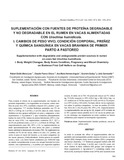Suplementación con fuentes de proteína degradable y no degradable en el rumen en vacas alimentadas con Urochloa humidicola. I. Cambios de peso vivo, condición corporal, preñez y química sanguínea en vacas brahman de primer parto a pastoreo

Voir/
Date
2014-11Auteur
Palabras Clave
Suplementación, Fuentes proteicas, Vacas de primer partoSupplementation, Protein sources, First calf heifers
Metadatos
Afficher la notice complèteRésumé
Para evaluar el efecto de la suplementación con fuentes de proteína degradable y no degradable en el rumen, sobre cambios de peso vivo (PV), condición corporal (CC), preñez y química sanguínea, 117 novillas Brahman gestantes con PV de 393,5 ± 3,05 kg de 3 (n=84) y 4 (n=33) años de edad, fueron divididas en tres grupos uniformes en peso y asignados a tres suplementos (1 kg·animal·d-1) que contenían principalmente harina de maíz (HM), harina de pluma hidrolizada (HPH) y harina de soya (HS). Los suplementos contenían 20,7;42,7 y 42,5% de proteína cruda, y 2,8; 2,7 y 2,8 Mcal de EM·kg-1 MS respectivamente para HM, HPH y HS. La suplementación se inició aproximadamente 45 días antes del parto y continuó hasta culminar la temporada de monta (TM). Se registraron los cambios de PV de las vacas, altura a la cruz, CC, preñez, así como el peso al nacer del becerro, y en suero sanguíneo de las vacas: glucosa, B-hidroxibutirato, ácidos grasos no esterificados y urea. Los datos fueron analizados por ANAVAR bajo un diseño completamente al azar con arreglo factorial 2x3 (dos edades, tres suplementos), y la preñez por regresión logística exacta. Al inicio de la TM, HS promovió mayor un PV (356,4 kg; P<0,05) respecto a HPH (339,0 kg) y HM (340,4 kg). La
CC al inicio de la TM fue mayor (P<0,05) en HS (2,75) respecto a HPH (2,62) y HM (2,63). No hubo efecto de los suplementos sobre la química sanguínea. La tasa de preñez (P>0,05) fue: 52,9; 64,7 y 62,2% para HM, HPH y HS, respectivamente. La suplementación con un kg de HS, mejoró el PV al inicio de la TM y generó menor pérdida de CC de vacas de primer parto; sin embargo, las magnitudes de estos cambios no fueron suficientes para mejorar el desempeño reproductivo.
Colecciones
Información Adicional
| Otros Títulos | Supplementation with degradable and undegradable protein sources in rumen on cows fed Urochloa humidicola. I. Body weight changes, body score condition, pregnancy and blood chemistry on brahman first calf heifers on grazing |
| Correo Electrónico | robertmora78@yahoo.com cfchicco@cant.net |
| ISSN | 0798-2259 |
| Resumen en otro Idioma | In order to evaluate the effect of supplementation with degradable and undegradable protein sources in rumen, on body weight (BW) changes, body score condition (BSC), pregnancy and blood chemistry, 117 Brahman pregnant heifers with BW of 393.5 ± 3.05 kg being 3 (n=84) and 4 (n=33) years old, were divided in three uniforms BW groups and assigned to three supplements (1 kg·animal·d-1) containing mainly corn meal (CM), hydrolyzed feather meal (HFM) and soybean meal (SBM). The supplements contained 20.7, 42.7 and 42.5% crude protein, and 2.8, 2.7 and 2.8 Mcal of ME·kg-1 DM, for CM, HFM and SBM, respectively. Supplementation started approximately 45 days prior calving and was maintained up to the end of the breeding season (BS). Cow’s BW changes, wither height, BSC, pregnancy, as well as calf birth weight were recorded, and in serum cow: glucose, B-hydroxy butyrate, nonesterified fatty acids and urea were measured. Data were analyzed by ANOVA in a completely randomized design with a 2x3 factorial arrangement (two ages; three supplements). Pregnancy was analyzed by exact logistic regression. At the beginning of the BS, SBM showed higher BW (356.4 kg, P<0.05) compared to HFM (339.0 kg), and CM (340.4 kg). Body score condition at the beginning of BS was higher (P<0.05) in SBM (2.75) in relation to HPH (2.62), and CM (2.63). There was not effect of supplementation on blood chemistry. Pregnancy rate (P>0.05) was: 52.9, 64.7 and 62.2% for CM, HFM and SBM, respectively. Supplementation with one kg of SBM, improved BW at the BS and generated the lower loss of BSC in first calf heifers; however, the magnitudes of these changes were not sufficient to improve reproductive performance. |
| Colación | 563-576 |
| País | Venezuela |
| Institución | Universidad del Zulia (LUZ) Universidad de Los Andes (ULA) |
| Publicación Electrónica | Revista Científica |
| Sección | Revista Científica: Producción Animal / Animal Production |





